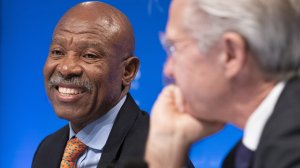The South African Reserve Bank (SARB) is poised to extend its longest easing cycle since 2019 on the eve of stiffer US trade tariffs, which are likely to weigh on the country’s already sluggish economic growth.
Most economists in a Bloomberg survey expect Governor Lesetja Kganyago to reduce the benchmark interest rate to 7% from 7.25% when he delivers the announcement shortly after 3 p.m. on Thursday at a press briefing north of Johannesburg. Traders are pricing in an 84% chance of a quarter-point cut.
The six-member monetary policy committee is also expected to be unanimous in their decision to cut rates again, according to a separate survey.
The decision will be given a day before a deadline by US President Donald Trump for nations to forge bilateral trade deals or face steep tariffs on their exports to the US, with South Africa’s set at 30%.
The SARB has estimated that in the worst case scenario a tariff at that level, with the world’s average levy at 10%, could shave as much as 0.6% off gross domestic product growth this year and add 0.4 percentage points to inflation. Kganyago has also warned it could cost the country 100 000 jobs in its agricultural and automotive industries.
The potential hit on growth, and with inflation being near the floor of the MPC’s 3%-to-6% target range for nine straight months, provides an opportunity for the panel to cut by 25 basis points, says Elize Kruger, an independent economist.
“I strongly believe that this scenario, in combination with the sluggish economy — it’s hardly going to give us 1% this year — I do think there’s scope for the further cut,” she said. “There’s a bit of room on the monetary side to still stimulate the economy without being unnecessarily brave. And the economy is also struggling with high interest rates.”
Thursday’s meeting may be the MPC’s last chance to lower rates before it confronts the impact of tariffs and an adjustment to its inflation target, said Patrick Buthelezi, economist at Sanlam Investment.
Technical work is under way to review South Africa’s inflation goal, which hasn’t been adjusted in more than a quarter of a century.
“The window for cutting is also closing; it’s going to be difficult to cut in the future,” Buthelezi cautioned. “I wouldn’t be surprised if this is the last, but depending on how the economy performs and reforms coming quickly.”
Still, some like Keabetswe Mojapelo, a macroeconomist at FirstRand’s Rand Merchant Bank, think there is an outside chance the MPC will hold to bide its time to assess the impact of the tariff fallout and choose to act later in the year.
“Arguments for a cut are there, but we’ll need to take into account that we have this risk of the tariffs,” Mojapelo said. “When there’s uncertainty and you’re trying to manage risk, you don’t react to what you don’t see, or what you don’t know.”
EMAIL THIS ARTICLE SAVE THIS ARTICLE FEEDBACK
To subscribe email subscriptions@creamermedia.co.za or click here
To advertise email advertising@creamermedia.co.za or click here











